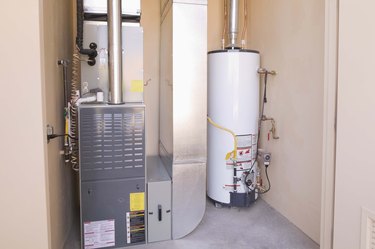
Flipping a switch and getting heat in your home requires a complicated series of actions by the parts of your gas furnace. The capacitor in a gas furnace starts the blower motor, but this operation is not in isolation. To understand the purpose of a furnace blower's capacitor, you must know how the entire furnace works.
Gas Furnaces
Video of the Day
Think of a gas furnace as a controlled gas fireplace in your basement. When you turn on the system, the electronic ignition switch sparks to light the pilot light. Older models use a standing pilot. This pilot light starts to heat the combustion chamber air. The capacitor in the blower starts the fan to begin circulating the warmed air through the ducts in your home.
Video of the Day
Capacitor Operation in the Blower
When the furnace starts up, the blower begins pushing air throughout your home. A control board attached to the blower determines when the blower should start. When the control board initiates the blower, the run capacitor closes the circuit to begin moving the blower fan. Without the capacitor, the blower would not start. In the winter, the fan should blow slowly to allow for a higher heat buildup in the combustion chamber before the air circulates through the house. A lower fan speed on the blower prevents those standing in front of the ventilation ducts from feeling a wind chill effect from the air moving too quickly.
Types of Capacitors
Most modern-day furnace blowers use permanent split capacitor motors. These do not have a start capacitor and rely only on a run capacitor to start the motor. Such permanent split capacitor blowers start slower and quieter than models with separate start and run capacitors. The simplified design of gas furnace blower motors makes repair easier if you suspect a problem with the capacitor because each motor has only one capacitor to fix.
Capacitor Problems
Diagnosing a problem with a blower's capacitor requires an understanding of the capacitor's function. Without the capacitor, the blower would not start because the run capacitor initiates the blower fan to start turning. When the run capacitor on a permanent split capacitor motor for a furnace is not working, the blower fan will not operate. The furnace will heat up, but the blower does not come on. The wiring should be checked for the proper electrical currant reaching all components before suspecting a faulty run capacitor. A non-working control board could also mimic a faulty capacitor because it does not send the signal for the capacitor to start the blower.